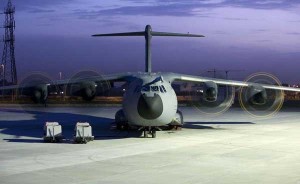Progress between 2008 and 2009 has been slow and not very substantial. The LOI repeats the basic instruments of enhanced co-operation as mentioned already in the DoI : “…among others: making available military transport aircraft; purchasing flying hours; providing or exchanging flying hours; providing and benefiting from shared and/or pooled aircraft and/or support functions.”
The LOI describes the fleet in its vision and scope paragraphs in three different ways:
- first, as a “flexible and inclusive partnership between national and multinational military air transport fleets and organisations in Europe…”;
- second, as a “networked fleet linking various European air transport fleets …” and,
- third, as an “innovative concept to enhance the airlift capacities”.
There is obviously a large degree of uncertainty around the project. The EATF concept is but one (though a rather inclusive) element in the European efforts to improve military airlift capacities.
Others are, in execution of the cherished principle of variable geometries:
- the European Air Transport Command (EATC), foreseen to take up its duties in Eindhoven (NL) from 2010 and which includes Belgium, France, German, Luxemburg and the Netherlands;
- a multinational A400M unit composed of BE,FR,GE and LU aircraft and agreed in a DoI in 2008;
- and a 21 member Movement Coordination Centre (MCCE) created in 2007 as a merger of the 2001 European Airlift Coordination Cell (EACC) and the 2001 Multinational Sealift Group (MSG), both offspring of NATO efforts to counter shortfalls in strategic transport capabilities.
Lots of process and organisations. But where is the beef ?
The A400M is not around the corner : the first test flight is scheduled for this November or December. Deliveries are 3 to 4 years off. C130s and C160s are reliable, but aging aircrafts and limited in payload and range.
A400M First Engine Test
(credit: EADS, November 2009)
The good news so far – in multinational terms, anyway – are NATO’s C17-fleet operating from Hungary (3 aircraft, commonly funded by 12 nations) and the 18-nations Strategic Airlift Interim Solution (SALIS) contract providing up to 6 AN 124-100 operating from Halle-Leipzig in Germany.
Looking at all the confusing alphabet soup and the multitude of activities in the EU and in NATO – how likely is it that the 17 November European Defense Agency Steering Board will be a robust starting point for the timely establishment of a much-needed European fleet – the EATF ?
The past 12 months (from the DoI to the LOI) have shown that the debate on a “governance system” for the EATF, or on the question whether the “F” in EATF means fleet or framework, has consumed more administrative energy than a thorough analysis of current and future resources and their co-ordinated usability would have required.
There is clearly an obsession with process and with pre-existing authority and turf. Here is a paragraph of the “governance” part of the 17 November LOI : “A Steering Board will be created to provide high-level guidance with the support of all available expertise. The first initial task will be to define a strategy towards the implementation of the EATF network, including a roadmap consistent with the imperatives of other existing and future air transport organisations.”
Question : How can there be a breakthrough if all walls remain intact ?
But there is some hope. While the LOI does not spell out a date when a EATF should have Initial Operational Capability, working groups will be created in order to specify legal and financial aspects of the project.
So far, EATF is still a framework, not a fleet yet.
———-
***Posted November 22nd, 2009


